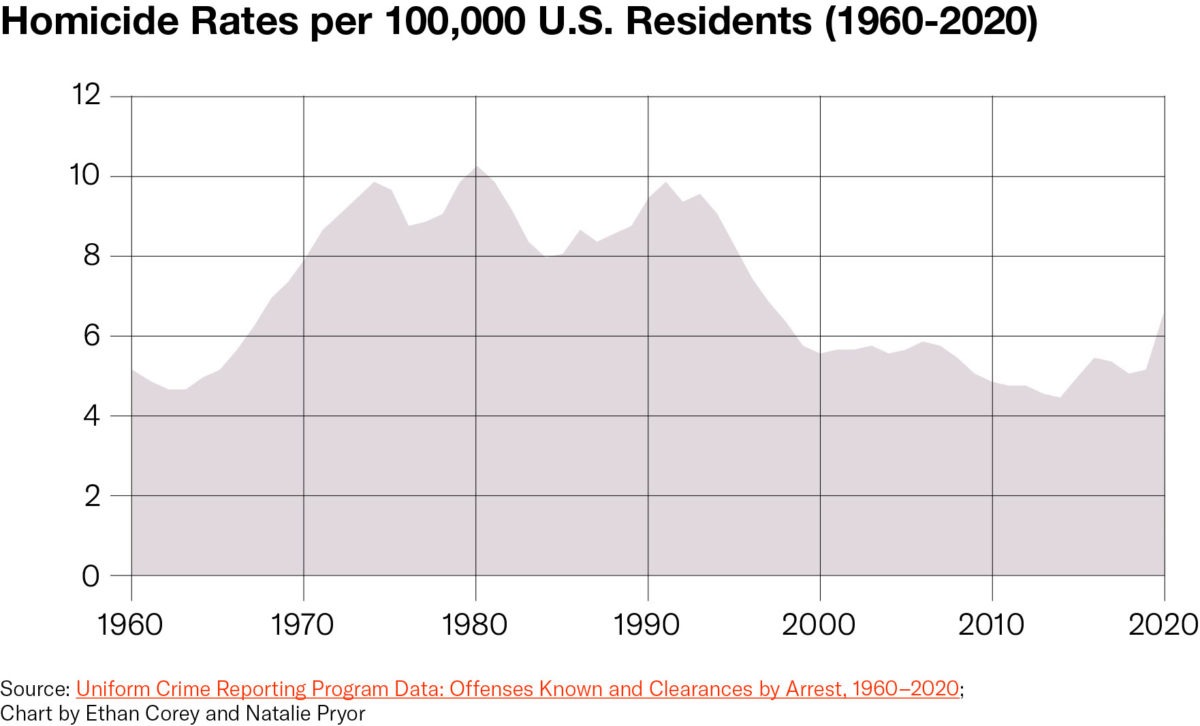Newsletter
The Recent Rise in Violence Should Be a Rallying Cry for Reform
Acknowledging the increase in homicides doesn’t mean giving in to the clamor for punitive responses. Instead, it should be a rallying cry for reform.

The following text appeared in the first edition of our weekly newsletter. Sign up here.
Earlier today, we announced that we’d completed our worker-led takeover of The Appeal. If you haven’t read our full statement, you can find it here.
As we continue to work toward an official relaunch, we decided we couldn’t wait to get back to doing what we love. Today we’re launching the first edition of The Appeal’s weekly newsletter! We’ll provide you with perspectives on the issues currently shaping the criminal legal system, along with a roundup of some of our favorite content from across the justice space. Each week you’ll hear from a different member of our team, or experts in the field.
And since we’re just getting started, we’d love to hear what you want to see us do with this newsletter. Please share your thoughts here.
We’re so excited to be back, and thanks for sticking with us!
SUPPORT A WORKER-LED APPEAL DONATE

The Recent Rise In Violence Should Be A Rallying Cry For Reform
by Nick Wing, The Appeal
Last week, the FBI published its Uniform Crime Reporting data for 2020. The annual dataset offers the most detailed accounting yet of crime during a year defined by a crushing pandemic and nationwide protests for racial justice following the murder of George Floyd. The report tells an incomplete story—mainly because it relies on voluntary reporting by police departments, which submit data slowly and inconsistently (and sometimes inaccurately). But the topline finding confirms what many had already understood to be an unusually violent year: Homicides rose by nearly 30 percent in 2020, the largest year-over-year increase since the U.S. began collecting national data in 1960. All told, more than 20,000 people were murdered in America last year at a rate not seen since the 1990s—though the U.S. murder rate remains substantially lower than the peaks of the 1980s and early 1990s.
Acknowledging this increase in homicides doesn’t mean giving in to the clamor for punitive responses. It doesn’t mean agreeing with the elected officials and law enforcement groups who’ve been given space in major publications to make unfounded claims blaming the violence on efforts to rein in abusive policing and the harms of mass incarceration.
This data is undeniably concerning, and it should serve as a rallying cry for those who believe violence can be better addressed with methods that don’t rely exclusively on police, prosecutors, and prisons. After all, that status quo is exactly what got us here. For all the debate in 2020 over “defunding the police” and other more modest reforms, few if any jurisdictions actually deviated significantly from the narrow framework that has defined public safety for decades.

Before we go on, a few clarifying points about the 2020 UCR report:
FIRST, while homicides increased in 2020, the data also confirms that overall crime—including robbery, rape, and burglaries—decreased nationwide. We can’t let valid concerns about violence give way to disingenuous fear-mongering about crime more broadly.
SECOND, the rise in killings last year was felt in every region of the country, across population size and political affiliation. Any attempt to attribute this to a single cause, or even set of causes, is completely dishonest.
THIRD, 2020 is just one year, and an incredibly abnormal one at that. Two data points do not make a trend. And while some preliminary data suggests that homicides continued to rise in the first half of 2021, albeit at a much slower rate than in 2020, we just don’t have enough data yet to make dire pronouncements—or rosy ones—about the murder rate.
Even if 2020 proves to be a statistical anomaly, that doesn’t mean we can ignore the violence that’s tearing through neighborhoods across the U.S. This bloodshed continues to take a disproportionate toll on Black and brown communities, which have historically felt the brunt of this issue and the failed responses to it. This is a crisis that kills, maims, and traumatizes residents. It drains communities of resources and opportunity, and gives way to an oppressive police presence that does further harm to the individuals they are supposed to be helping.
Despite rhetoric from law enforcement officials—who believe that any criticism of racist, out-of-control policing threatens the supposed “thin blue line” between order and chaos—the spike in homicides last year occurred in a nation where police remain the only well-funded resource for addressing violence. These murders occurred on their watch, at a time when police budgets mostly increased. The 2020 data shows alternatives are not just possible, but necessary. And as some cities have already begun to see, non-police methods of violence prevention can be effective, at a fraction of the cost—both social and monetary—of policing.
There are plenty of tools and strategies that can be used to address violence, without doubling down on the punitive mindset that has done so much harm. We can meet this crisis head on by investing in these alternatives—but only if we’re willing to acknowledge the need for urgency and respond by fighting for solutions that make us all safer.
IN THE NEWS
Contact us at theappealteam@gmail.com so we can feature your work here!
Appeal alum Lauren Gill investigated the unprecedented surveillance of mail sent to people incarcerated at federal prisons and the toll it takes on those inside. Instead of a card or handwritten letter, incarcerated people often get scanned, sometimes illegible copies. “It’s just like receiving a fake dollar bill,” one incarcerated person said. [Lauren Gill / The Intercept]
Appeal transition staff members Ethan Corey and Elizabeth Weill-Greenberg reported last month on the case of Anthony Sims, who has served more than 20 years in New York prisons for a murder he says he did not commit. The Brooklyn DA’s conviction review unit declined to review his case in 2016 without even interviewing him. The head of the CRU at the time, Mark Hale, was the prosecutor who put Sims in prison. [Ethan Corey and Elizabeth Weill-Greenberg / New York Focus]
Former Appeal reporter George Joseph and New York Focus editor-in-chief Akash Mehta combed through data to find out exactly who is responsible for driving up the number of people waiting for their trials at Rikers. (Spoiler alert: It’s judges.) [George Joseph and Akash Mehta / Gothamist & New York Focus]
Bonus: A chart showing the NYC judges with the highest rates of setting bail.
After the release of 2020 crime data, media outlets were quick to platform voices suggesting the rising violence was due to backlash over last summer’s protests against police abuse. Former Appeal contributor Jon Ben-Menachem has a new column outlining the dangerous logic of the so-called Ferguson Effect—a debunked criminological theory that claims “de-policing” or “police pullback” cause increases in crime. [Jon Ben-Menachem / Slate]
Congress is moving forward with legislation to eliminate the crack/powder cocaine sentencing disparity. The disparity had been reduced in 2010 from a 100-to-1 ratio to an 18-to-1 ratio. [Sarah N. Lynch / Reuters]
Two narcotics officers with the Columbus, Ohio, police department were arrested for allegedly attempting to distribute nearly 8 kilograms of fentanyl. (And to think cops keep telling us they can OD just from touching fentanyl dust.) [Associated Press]
A tough-on-crime Republican district attorney in Pennsylvania has been charged with rape after allegedly showing up at a professional acquaintance's home uninvited and violently assaulting her. He's not the first DA in the state charged with sexual assault this year: In February, a prosecutor in another county was accused of sexually assaulting at least five women. [Dave Sutor and David Hurst / The Tribune-Democrat]
Alabama is proceeding with plans to use $400 million in COVID relief funds to build new prisons. [Mike Cason / AL.com]
A judge in New York tried to send an immunocompromised homeless man to Rikers—for allegedly stealing blankets. [Nick Pinto / The Intercept]
Sean Worsley, a decorated veteran with a Purple Heart, was sentenced to five years in prison in Alabama for bringing his legally prescribed medical marijuana from Arizona to Alabama. He was released on parole last fall, but the conviction has continued to haunt Worsley and his wife, who have since struggled to find work and housing. [NOVA | PBS]
Maryland police reforms started going into effect on Friday. When cops kill someone, “a new team of independent investigators will show up at the scene and sort out what happened,” the Baltimore Sun reported. “And when misconduct complaints are made against officers, they will be public.” [Jessica Anderson and Pamela Wood / Baltimore Sun]
The UCR data we discussed at the beginning provides a lot of numbers to wade through, and there are important caveats and limitations to consider. This new open-source book by Jacob Kaplan, the chief data scientist at Research on Policing Reform and Accountability, has tons of great info to help you avoid pitfalls while analyzing and interpreting the data. [Jacob Kaplan / UCRbook.com]
That’s all for this week. Feel free to leave us some feedback, and if you want to support our official relaunch, please donate here. Until next time, the work continues.
